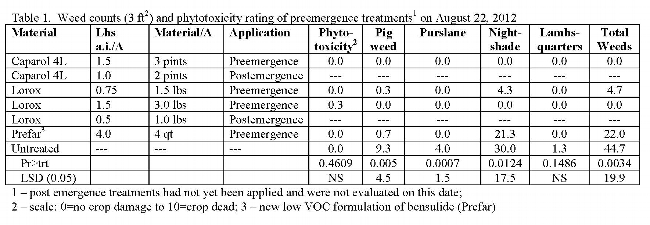Cilantro was produced on 5,543 acres in Monterey and Ventura Counties in 2011. The production of cilantro has shifted to high density 80-inch wide beds and a large proportion is now mechanically harvested. Hand weeding high density beds is very expensive and reduces the economic viability of this crop. As a result, there is a need for excellent weed control. Two broadleaf herbicides were registered on cilantro: Prefar and Caparol. Prefar was registered for a number of years and provides good control of a number of key weeds in cilantro such as purslane, lambsquarter and pigweed. Caparol was registered in 2012 and provides good weed control of a wider spectrum of weeds including the nightshades, shepherd’s purse, sow thistle, groundsel and others (see tables below).
Here is the situation with Prefar: EPA moved cilantro (also Mexican & Chinese parsley) out of the "Leafy vegetables" crop group 4 and placed it in the "Herbs and Spices" crop group 19. The issue is that crop group 19 Herbs and Spices has no tolerance for Prefar. Without a tolerance, Gowan Corp. can no longer support the 24c for cilantro. It places growers in a tricky situation, because they may have Prefar with the old label in reserve, but any detectable levels of Prefar residues are detected on cilantro, it could result in seizure of the crop. This is a regulatory snafu that may take some time to untangle; work is being done to resolve this situation but it is unclear how long it will take to resolve.
Caparol is also registered for use on cilantro, but there is a plant back restriction of 12 months prior to planting lettuce, broccoli, cauliflower and spinach. This is of course very difficult to work with this restriction in the Salinas and other coastal valleys.
Other weed control options: bed fumigation of cilantro prior to planting can be highly effective, but issues with the cost and working around buffer zones makes this option difficult to fit into a grower’s production budget as well as schedule. Cultural practices such as pregermination followed by shallow cultivation of emerged weeds prior to planting can help reduce weed pressure. Cilantro seed germinates slowly which opens the possibility of burning off a flush of weeds (with an herbicide or propane flamer) following planting but prior to the emergence of the cilantro. This is a tricky, but highly effective technique for reducing weed density.
In summary, we have a number of regulatory issues that need to be addressed in order use the broadleaf herbicides without difficulty. We will need to continue to work with the regulators and registrants to resolve these issues as quick as possible.
(Click on tables and images to Enlarge)
Attached Images:


